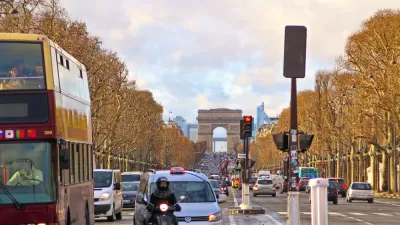As of press time on Friday, the death toll from the Nice Bastille Day massacre is 84, injuries exceeding 200, a record for an act of alleged terrorism committed by a single person. It also sets a record for death by the use of a motor vehicle.

When I initially heard on Thursday afternoon that a truck had caused dozens of deaths at a Bastille Day celebration in Nice, France, and that the truck was laden with weapons and explosives, I thought the media was describing a "truck bomb." As the details of the largest mass murder of people by a single individual were revealed, it was made clear that the main weapon was the truck itself, being driven by someone intent on killing as many innocent civilians as possible.
"Just before the carnage Thursday night, hundreds, if not thousands, had gathered on the promenade to watch a colorful display of fireworks and live music for the national holiday," reports CNN.
"Starting around 10:45 p.m., the attacker mowed down scores of victims in Nice with a rented 19-ton refrigerated truck before engaging in a gunfight with three police officers, who pursued him down a storied seaside promenade before finally killing him," reports The New York Times.
The driver was allegedly Lahouaiej Bouhlel, a 31-year-old French-Tunisian delivery driver "known to the police for assault with a weapon, domestic violence, threats and robbery but had no previous convictions for terrorism," reports The Telegraph.
Motor vehicles intentionally used as deadly weapons
Bouhlel undertook "a tactic authorities have warned about for several years," writes Alex Johnson for NBC News.
As early as December 2010, the U.S. Department of Homeland Security issued an alert to law enforcement warning that "such attacks could be used to target locations where large numbers of people congregate, including sporting events, entertainment venues, or shopping centers."
So-called vehicle ramming is alluring to potential attackers because it offers them an opportunity to conduct strikes without firearms or explosives and with "minimal prior training or experience," DHS said. [Italics added.]
As for firearms and explosives, incredibly, all those initial reports were way off. Other than a handgun, the weapons and explosives were either non-existent or fake, according to CNN.
After Bouhlel was shot, police found a handgun and some ammunition in the truck's cab, as well as a replica handgun, two replica assault rifles, a cell phone and various documents, Molins said. In the trailer was the bicycle and some empty pallets.
Bouhlel was known as someone who biked everywhere, even carrying it up the stairs to his apartment. He used that bicycle to ride to the lorry-rental facility.
Back to the DHS warning about such attacks. Johnson of NBC continues:
The [DHS] bulletin advised officers to be especially alert for "commercial motor vehicles or heavy equipment being operated erratically, at unusual times, or in unusual locations, particularly in heavy pedestrian areas."
Johnson goes on to list examples of vehicles used by individuals as weapons of carnage:
- 1995, San Diego: an army veteran stole a tank, but no fatalities other than himself.
- 2006, North Carolina: Iranian former student used SUV to plow into crowd, no fatalities.
- 2009, Netherlands: potential royal family assassin plows into parade with car, eight fatalities.
- 2014, Saint-Jean-sur-Richelieu, Quebec: "ISIS-inspired" terrorist rams into two Canadian soldiers in the parking lot of a shopping center, one dies.
- 2014, Jerusalem: terrorist slams into a crowd of people at a light rail stop in Jerusalem, killing two.
- 2014, Dijon and Nantes, France: Two men crash their cars into groups of pedestrians on successive days. Eleven people are injured in Dijon, and the next day, one person is killed and nine others are injured in Nantes.
FULL STORY: A Short History of Vehicles Being Used as Deadly Weapons

Alabama: Trump Terminates Settlements for Black Communities Harmed By Raw Sewage
Trump deemed the landmark civil rights agreement “illegal DEI and environmental justice policy.”

Planetizen Federal Action Tracker
A weekly monitor of how Trump’s orders and actions are impacting planners and planning in America.

The 120 Year Old Tiny Home Villages That Sheltered San Francisco’s Earthquake Refugees
More than a century ago, San Francisco mobilized to house thousands of residents displaced by the 1906 earthquake. Could their strategy offer a model for the present?

In Both Crashes and Crime, Public Transportation is Far Safer than Driving
Contrary to popular assumptions, public transportation has far lower crash and crime rates than automobile travel. For safer communities, improve and encourage transit travel.

Report: Zoning Reforms Should Complement Nashville’s Ambitious Transit Plan
Without reform, restrictive zoning codes will limit the impact of the city’s planned transit expansion and could exclude some of the residents who depend on transit the most.

Judge Orders Release of Frozen IRA, IIJA Funding
The decision is a victory for environmental groups who charged that freezing funds for critical infrastructure and disaster response programs caused “real and irreparable harm” to communities.
Urban Design for Planners 1: Software Tools
This six-course series explores essential urban design concepts using open source software and equips planners with the tools they need to participate fully in the urban design process.
Planning for Universal Design
Learn the tools for implementing Universal Design in planning regulations.
Clanton & Associates, Inc.
Jessamine County Fiscal Court
Institute for Housing and Urban Development Studies (IHS)
City of Grandview
Harvard GSD Executive Education
Toledo-Lucas County Plan Commissions
Salt Lake City
NYU Wagner Graduate School of Public Service




























